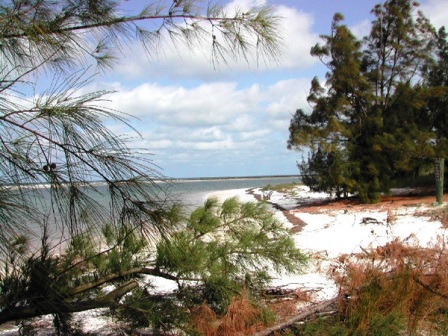Discover Florida Nature
It's time to explore the natural Florida


|
|
|
|
|
 The
island of Anclote Key houses both the Anclote Key State Preserve and the
Anclote National Wildlife Refuge. Accessible only by private boat, this
island park has a lighthouse and wildlife area that is a sanctuary for
rare and endangered species. Blue-green Gulf waters lap gently along the
preserve´s beautiful four-mile-long beach. About 1,000 years ago this
island was pushed up from the Gulf floor to rest on a limestone
platform. Its geologic growth hasn’t stopped. Recent research has
documented a 30 percent increase in the size of Anclote since 1957.
Anclote Key is the largest of a collection of small islands, known as
the Anclote Keys, found three miles offshore from Tarpon Springs and the
mouth of the Anclote River. The islands were named Anclote, Spanish for
anchor, due to the method Spanish sailing vessels would use to navigate
the shallow channels in the area. The navigation was accomplished by
attaching a line to a kedge anchor, dropping the anchor at a distance in
the desired direction of travel, and then using the line to pull the
boat to the anchor. Although the name Anclote appears on maps dating as
far back as 1715, it wasn’t until the mid 1860s that the area was
permanently settled. The
island of Anclote Key houses both the Anclote Key State Preserve and the
Anclote National Wildlife Refuge. Accessible only by private boat, this
island park has a lighthouse and wildlife area that is a sanctuary for
rare and endangered species. Blue-green Gulf waters lap gently along the
preserve´s beautiful four-mile-long beach. About 1,000 years ago this
island was pushed up from the Gulf floor to rest on a limestone
platform. Its geologic growth hasn’t stopped. Recent research has
documented a 30 percent increase in the size of Anclote since 1957.
Anclote Key is the largest of a collection of small islands, known as
the Anclote Keys, found three miles offshore from Tarpon Springs and the
mouth of the Anclote River. The islands were named Anclote, Spanish for
anchor, due to the method Spanish sailing vessels would use to navigate
the shallow channels in the area. The navigation was accomplished by
attaching a line to a kedge anchor, dropping the anchor at a distance in
the desired direction of travel, and then using the line to pull the
boat to the anchor. Although the name Anclote appears on maps dating as
far back as 1715, it wasn’t until the mid 1860s that the area was
permanently settled.The park is home to at least 43 species of birds, including the American oystercatcher, bald eagle, and piping plover. A picturesque 1887 lighthouse stands as a sentinel on the southern end of the island. When out at Anclote Key or Anclote Bar, you may notice the many shorebirds that rest and nest here. These northernmost barrier islands are considered by experts to be among the top five sites in the state for diversity and numbers of beach-nesting birds. Species such as the Piping Plover winters here, but can be found almost any month of the year. Nesting activity for most of these birds can begin as early as March and may last through to August. However, resting occurs year-round. It is vital to the birds survival not to disturb them while they are feeding or resting. They use precious energy stores every time they are flushed in the air. The Anclote Key Lighthouse sits on the southern tip of Anclote Key off the coast of Tarpon Springs at the mouth of the Anclote River, on Florida's western coast. Built in 1887, the weathered and beaten tower still stands today. The land for the lighthouse had been acquired in 1866, but funds for its construction were not made available until Congress appropriated $17,500 on March 3, 1885. The Lighthouse Board intended to build a skeletal tower similar to the Cape San Blas Lighthouse, which had just been completed at a cost of $35,000. A request was thus made for additional funds, and Congress responded with another $17,500 on August 4th of the following year. The tower was prefabricated in the north and then shipped to the island, arriving in June of 1887. It took just three months to assemble the cast-iron structure, and keeper James Gardner lit the light for the first time on September 15th. The tower’s lantern room is supported by a central cylinder, which houses a spiral staircase, and four supporting columns, which slope outwards to form a square, pyramidal structure. Four levels of horizontal braces connect the central cylinder to the supporting columns. A revolving third-order Fresnel lens was originally used in the tower to produce four, grouped white flashes every thirty seconds. In 1899, the signature was changed to one red flash every thirty seconds. |
|
|
Anclote Key Florida
The island of Anclote Key houses both the Anclote Key State Preserve and the Anclote National Wildlife Refuge. Accessible only by private boat, this island park has a lighthouse and wildlife area that is a sanctuary for rare and endangered species. Blue-green Gulf waters lap gently along the preserve´s beautiful four-mile-long beach.
Enjoy the blue-green Gulf waters that lap gently along the sandy beaches of the four islands that make up Anclote Key Preserve State Park - Anclote Key, North Anclote Bar, South Anclote Bar and Three Rooker Island. Anclote Key is Floridian nature at its best!
Written by: Brenda Arnold
Anclote Key State Park
Date published: 10/22/2013
5 / 5 stars
|
|